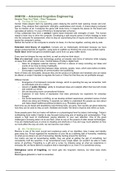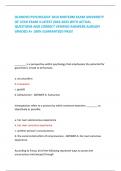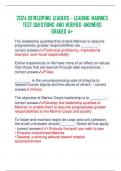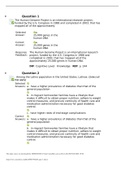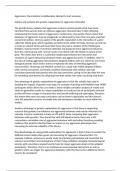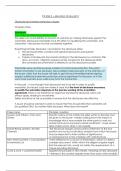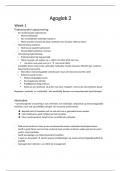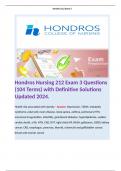0HM150 – Advanced Cognitive Engineering
Smarter Than You Think – Clive Thompson
1. The Rise Of The Centaurs
Human chess players learn by spending years studying the world’s best opening moves and end-
games. They analyze their opponents’ strengths, weaknesses and moods. A chess playing computer
has no intuition at all. It analyzes the game with brute force; it inspects the pieces on the board and
calculates all options. It’s way of thinking is fundamentally unhuman.
If they collaborate they form a centaur: hybrid beast endowed with strengths of each. The human
needs to learn how to drive the computer. Developing a split second sense of which strategy to enter
into the computer for assessment, when to stop an unpromising line of inquiry and when the accept or
ignore the computer’s advice.
Neither the human or the computer is smarter at chess, it is the two together, working side by side.
Extended mind theory of cognition: humans are so intellectually dominated because we have
always outsourced bits of cognition, using tools to scaffold our thinking into ever-more-rarified realms.
Rodin ideal: belief that genius breakthroughs come from our gray matter alone.
Every new tool shapes the way we think, as well as what we think about.
Bias of a new tool: every new technology pushes us towards new forms of behavior while nudging
us away from older, familiar ones. Central biases of today’s digital tools:
- Allow for prodigious external memory: shift from a stance of rarely recording our ideas and
events of our lives to doing it habitually.
- Make it easier to find links between ideas, pictures, people, news, which were before invisible.
- Encourage a superfluity of communication and publishing.
None of these are immutable, because they are the product of software and hardware and can easily
be altered or ended if decided to regulate the tools or if they find that they are not profitable enough.
Different trends:
- Emergence of omnipresent computer storage, which is upending the way we remember, both
as individuals and as a culture.
- Advent of ‘public thinking’: ability to broadcast ideas and catalytic effect that has both inside
and outside our minds.
- We are becoming more conversational thinkers
- Explosion of new forms of expression that were previously too expensive for everyday
thought.
- Our social awareness is shifting, as we develop ambient awareness: persistent sense of what
others are doing and thinking. It expands our ability to understand the people we care about
and helps dispel traditional political problems (e.g. Pluralistic ignorance).
Each time we are faced with bewildering new thinking tools, we panic, then quickly set about deducing
how they can be used to help us work, meditate and create. We tend to improve and refine our tools.
Some people panic that our brains will deform on a physiological level by today’s technology. Today’s
multitasking tools make it harder to stay focused during long acts of reading and contemplation. They
require a high level of mindfulness; paying attention to your own attention. One of the great
challenges is knowing when not to use them, when to rely on the powers of older slower technologies.
If we are intellectually lazy or prone to cheating and shortcuts or if we don’t pay much attention to how
our tools affect the way we work, we can become over reliant.
2. We, The Memorious
Memory is one of the most crucial and mysterious parts of our identities, take it away and identity
goes away too. Proust regarded the recollection of your life as a defining task of humanity; mediating
on what you’ve done is an act of recovering, literally hunting around for lost time.
Our brains are bad at remembering details, they are great at getting the gist of something, but
consistently muff the specifics. If we remembered every single detail, we wouldn’t be able to make
sense of anything. Forgetting is a gift and a curse; by chipping away at what we experience in
everyday life, we leave behind a sculpture that’s meaningful to us, even if it is sometimes wrong.
Ebbinghaus curve of forgetting: not much gets into long-term memory, but what does sticks
around.
Meaningless gibberish is hard to remember.
1
,Your ability to recall something is highly dependent on the context in which you are trying; it is easier if
you have the right cues. Committing something to memory is simpler if you are paying close attention.
Even when we remember an event, it is not clear if we remember it correctly. Memory is active.
You regenerate memory: you know accurate gist but fill in missing detail with stuff that seem
plausible.
The organic brain may contain mistaken memories, but generally it finds things instantaneously and
fluidly and it is superb at flitting from association to association.
Real promise of artificial memory is not its use as a passive storage device, but that it is active, trying
to remember things for us. Lifelogs will be more useful when they use brute-force pattern finding.
3. Public Thinking
Sturgeon’s law: ninety percent of everything is crap.
Reading changes the way we think. It helps us formulate thoughts that are more abstract, categorical
and logical. How is writing changing our cognitive behaviors?
- Helps clarify your thinking.
- Online writing is almost always done for an audience, which clarifies the mind even more.
- Improves memory: write about something and you will remember it better generation
effect.
Audience effect: shift in performance when we know people are watching. Isn’t always positive. Does
not need a big audience. Especially when it comes to analytic or critical thought, effort of
communicating to someone else forces you to think more precisely, make deeper connections and
learn more.
‘reading maketh a full man, conference a ready man and writing an exact man’ (Baker).
Once thinking is public, connections take over. Failed networks kill ideas, successful ones trigger
them.
Theory of multiples: world’s biggest breakthrough ideas often occur simultaneously to different
people/ Why our ideas are partly products of our environment, they are evitable. When they are
ready to emerge, they do. The things we think about are deeply influenced by the state of the art
around us.
Public thinking works best when people are not worried about owning ideas. The existence of
multiples is enormously exciting if you are trying to solve a problem or come to an epiphany. If you are
trying to make money, it can be a problem.
Minskey describes human smarts as stemming from various ways our brains will tackle a problem: we
will simultaneously throw logic, emotion, metaphor and crazy associative thinking at it.
Tummeling: mix of persuasion, listening and good hosting. Tummlers are social adepts of online
conversation. It works only when you control the space and can kick out undesirables.
4. The New Literacies
Literacy: being able to read and write.
Computational power isn’t just changing old literacies, but it creates new ones.
Tools matter; good ones help us think well, bad ones do the opposite.
‘maker’ movement; worldwide collection of nerds trying to learn and teach everyday mechanical and
electronic know-how, has arisen in the age of easy video documentation.
If you want to know how to build something, seeing it happen is crucial.
For video to advance as a medium for thinking, there is one major shift that will have to occur: we will
need to begin using it to communicate with ourselves. Right now, the moving image is inextricably tied
to the idea of broadcasting to an audience.
Average person today is much more literature in photography and networked, which makes her
smarter.
Photo editors at newspapers used to worry that truth was dying in photos, but reverse is happening.
Corporate photomanipulations are increasingly scrutinized and mocked for inauthenticity.
Today’s software is still terrible at scanning images; even if it can autodetect a particular image, it
can’t figure out if you are using it to make an ironic point. That is an act of deep-meaning perception
that makes machines can’t match, for now anyway.
2
, As we develop more new modes for expressing ideas and recording knowledge, challenge will be
figuring out when to use in which form. Each mode is useful for some thinking and awkward for
others.
5. The Art Of Finding
Tip of the tongue syndrome generally lasts only a minute and your brain finally makes the
connection. When we have such a moment many of us begin to rely instead on the internet to locate
the information.
A Chinese technician developed advanced printing technology ahead of Gutenberg. But Mengde
complained that written records not only reduced the art of memory, but increased damage of factual
errors. Once enshrined in text, a false act assumed authority and would be repeated. There was no
easy way, once printed, to amend a book.
Blair said that when books were scarce, the literate would read and reread the few precious, rare texts
to which they had access, gradually committing them to memory. But as books became plentiful
readers shifted from intensive reading to our more contemporary mode of extensive reading; reading
widely, but rarely rereading. This shift prompted fresh fears that nobody was retaining knowledge.
Socrates was right: as print grew, fewer and fewer thinkers relied on mental palaces. Virtually no one
today can recite long passages from memory. But what he did not foresee was the types of complex
thought that would be possible once you no longer need to mentally store everything you encounter.
Renaissance thinkers devised techniques that made their reading re-browsable (e.g. note taking).
Memex: device in which an individual stores all his books, records and communications and which is
mechanized so that it may be consulted with exceeding speed and flexibility (bush). It is an enlarged
intimate supplement to his memory.
Metamemory: aware of mental strengths and limits and we are good at intuiting the abilities of others.
Transactive memory (Wegner): two heads are better than one. We share the work of remembering,
because it makes us collectively smarter, expanding our ability to understand the world around us. We
don’t remember in isolation and that is good. We record as much outside our minds as within them.
When information is located inside someone you trust, it’s a mind expander.
Transactive memory helps explain how we are evolving in a world of on tap information. If we know a
digital tool is going to remember a fact, we are slightly less likely to remember it ourselves. We are
however confident of where we can refind it.
In some ways machines make for better transactive memory buddies than humans. They know more,
but they are not awkward about pushing it in our faces.
Real challenge of using machines for transactive memory lies in the inscrutability of their mechanics.
Transactive memory works best when you have a sense of how your partners’ minds work, where
they are strong, where they are weak where their biases lie. But it is harder with digital tools,
especially search engines.
Collaborative inhibition: when two people have methods of remembering information that actively
clash with one another. In this situation, they can actually remember less together than separately.
The more you know about a field, the more easily you can absorb facts about it. Outside your field of
specialty, the ability to absorb facts isn’t going to be above average.
Juggler’s brain: mind that can’t learn things because it doesn’t stand still long enough.
6. The Puzzle-Hungry World
The fun in a game isn’t in having mastered it. It’s in the process of mastery, of figuring out the invisible
dynamics behind how the thing works, revealing it’s secrets.
Two heads are not just better than one, they are exponentially so.
Video-game world was the first major industry to encounter the cognitive power of a highly connected
audience. It learned that a vast community of networked people isn’t just smart; it is restless and
hungry for complex problems.
3

